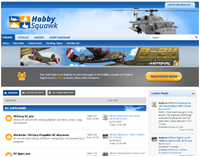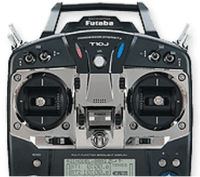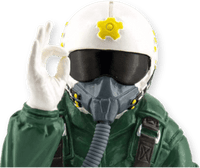Airbrushing and Weathering 101
by Todd BredaWhen it comes to weathering my warbirds I am admittedly and pathetically late to the party. I have no real excuse especially since I love to paint nearly all of my models. For me that can include a complete radical departure from the stock livery at times. For instance, I've painted several Freewing 90mm F/A-18's the Blue Angels livery from its original stock grey livery.
The end result has always been rewarding for me. Yet, for some inexplicable reason, I kept putting off investing in an airbrush system to really get into the limitless world of weathering and fine blending/gradient detail that only an airbrush can provide.
Well, it's better to be late to the party then miss it altogether, right?
So here we are...Several years into the hobby and I have finally pulled the trigger on an airbrush setup. I found an inexpensive system on Amazon.com that was recommended by someone I respect who has a lot of experience with airbrushing.
Let me be perfectly clear. As you can probably tell by now I am in no way an expert in airbrushing. In fact, I am a novice. If you are looking for detailed instructions on airbrush techniques, maintenance and general how-to's I would recommend starting on YouTube. There are countless video tutorials on YouTube that are immensely helpful in teaching you the basics of airbrush operation and technique.
What this article is for is to offer basic Tips and Tricks I have learned thus far when it comes to airbrushing, weathering and adding detail to your precious warbird.
As I learn more, I will be adding to this article for the benefit of others seeking this kind of help and information. So let's get started.
AIRBRUSHING 101
Your Airbrush System Doesn't Have To Be Top Of The Line To See Quality Results
One thing I've learned is when you first get an airbrush system, don't worry so much about a top of the line airbrush. What you want is a decent air compressor. You can always move on to a more professional airbrush once you get familiar with airbrushing. A decent compressor is something that will work effectively for you whether it's pushing air through a low end or top quality airbrush.
With my particular kit, that is indeed the case. While the airbrush itself is what advanced airbrushers would call low end, it still is more than enough to do the job. The compressor is decent enough that I can upgrade to a better airbrush once I feel ready to do so.
Hose sizes are pretty universal but in some cases there are airbrushes that may require an adapter to fit your compressor properly. These adapters are pretty inexpensive so it won't break the bank if or when the time comes that you would like a higher-end airbrush that requires an adapter.
Find A Paint Setup That Works For You
One of the nice things about airbrushing is that you can use a wide variety of paints. From water-based to enamel and beyond, there's plenty of options. The obvious advantage of using water-based acrylics as example is that it is much easier to clean where lacquers and enamels require proper associative solvents to clean the airbrush thoroughly. Heck, you can even use food coloring to practice.
There's no right or wrong, it's whatever you choose that works for you. Just make sure you research the differences with the paints depending on what you are wanting to do. For the most part, weathering our models can be done using any kind of paint we feel comfortable with.
When Mixing Paint, Use The "80/20" Rule
When using standard non-water-based paints, be sure you use an approximate "80/20" ratio meaning 80 percent of paint and 20 percent of the appropriate thinner. The reason for this is because your airbrush could become easily clogged if you run just the paint itself through the spray needle. By adding approximately 20 percent of thinner with the paint this will keep your needle from clogging and will make the cleaning process much easier for you.
A Clean Airbrush Is A Happy Airbrush
Whatever type of paint you end up choosing, you must make it a habit to clean your airbrush completely and thoroughly after each use (and between different paint colors). Any airbrush whether it's an economy one or a fancy-pancy model is a precision instrument. There's a lot of tiny little parts that together create good and proper airflow for your artistry. An unclean airbrush will clog the needle which creates spatter and other assaults on your good character which will make you choose rather unsavory language faster than you can say "#$%@!"
WEATHERING 101
Above All Else, The Number One Mantra In Realistic Weathering Is "Less Is More!"
Remember those visuals of a student at a chalkboard writing something like "I will not disobey my teacher again" or something similar over and over and over again? Well replace that visual with "When it comes to weathering my warbird, less is more!" over and over again and keep that visual firmly in your mind's eye at all times.
Yes, it can't be overstated enough.
The number one thing I see people do wrong when it comes to weathering is overdo it. Especially panel lines. It's very easy to do it because the airbrush is a very sensitive instrument where it doesn't take much paint at all for realistic panel lines and weathering.
(At the end of this article please take the time to watch the very informative video which I have found offers some really excellent realistic weathering techniques.)
For instance with panel lines many folks will use tape on a panel line (for this example let's say a vertical panel line on the pilot or port side of the fuselage). You would place the tape directly on the panel line where the paint line would fall in the direction of the prop wash so in this case the paint would be on the right side of the tape.
A good technique is to start painting ON the tape itself and slowly make your way to the edge of the tape you want the panel line to show. The concept here is once you make your way to the edge of the tape you are applying a very thin line of paint. So fine a line in fact you may not even notice hardly any paint. This is okay! Once you remove the tape you will be surprised how little it takes to show the paint line.
This is where people overdo it. The tendency is to keep painting until the line darkens where you can see the line clearly. However by doing so once you remove the tape you will see the line is very dark. Often, too dark.
Remember, real panel lines on warbirds both original and restored are not very pronounced. You must guard against the temptation to paint heavy panel lines. Some folks seem to think if the panel lines are easy to see it will showcase their weathering job better. This is far from the truth.
The trick with scale weathering isn't pronounced panel lines, it's in the various tools and methods that create the illusion of oils, exhaust, chips and other subtle elements that simulate the effects of the engine, mechanical systems and environment the real warbirds flew in.
Take the time and advantage of the Internet to research the effects of weathering on the full scale version of the warbird model you are detailing. There are countless photos of full scale and model warbirds displaying realistic weathering. The more you study these photos the more realistic your attempts will be at simulating the same effects on your model.
This video offers some excellent weathering techniques for your warbird. Remember, if you make a mistake, you can fix it. The key is to be subtle, always keep your airbrush cleaned between colors and usage and protect yourself with proper ventilation and a proper mask when painting with enamels and lacquers. But most importantly, have fun!
Get the latest from Motion RC sale and product announcements
You can unsubscribe at any time!

Hobby Squawk Community Forum
visit forum
RC Knowledge Blog
visit blog
Guidance & advice for beginners
Find out more- Choosing a selection results in a full page refresh.
- Press the space key then arrow keys to make a selection.



